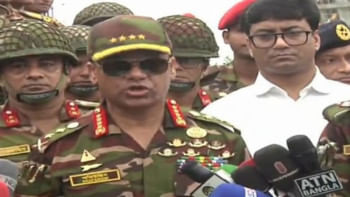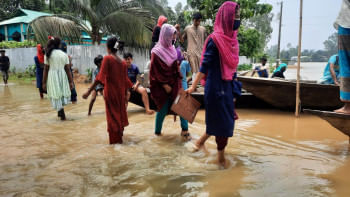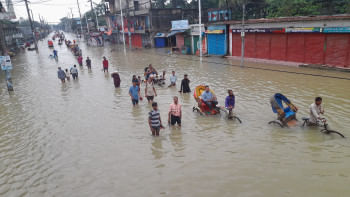Low-lying Dhaka areas could be flooded by month-end

Bangladesh's northern and central regions are expected to face brief flooding, as water levels in the Jamuna and Teesta rivers are rising steadily.
According to officials and experts, the ongoing flood in the country's north is likely to last for the next seven to 10 days, and the flooded area is also likely to expand.
The flood situation in the Sylhet division is anticipated to improve starting on Wednesday, but in the northern part of the country, including Panchagarh, Nilphamari, Lalmonirhat, Kurigram, Jamalpur, Gaibandha, Sherpur, Sirajganj, and Bogura, things are likely to get worse, they said.
"The good news is that the flood situation in Sylhet division will start improving from Monday, and within three days, flood water will fall significantly," Mostofa Kamal, PhD and researcher at University of Saskatchewan, told The Daily Star today.
The Teesta and Jamuna rivers' water levels will keep rising, which is the bad news he said.
"Hence, existing flood conditions along the banks of the two rivers will deteriorate further. Especially the flood condition in Gaibandha, Kurigram, Jamalpur, Sherpur, Bogura, and Sirajganj will deteriorate in
the next seven days," Kamal said, adding that already the water level in the Jamuna river is flowing one metre above the danger level, and the low-lying areas of Dhaka could be submerged by the end of this month.
There is a strong probability that flood conditions may develop in the central region of Bangladesh after June 23, when the water from Jamuna and the water that is draining from Sylhet division combine, said the environmental researcher.
According to the Flood Forecasting and Warning Centre, water-level of all the major rivers of the country are in rising trend.
It also said due to raining in the northern and north-eastern regions of the country along with adjoining Indian states of Assam, Meghalaya and Sub-Himalayan West Bengal of India in next 48 hours, the
Brahmaputra-Jamuna, Ganges-Padma, Surma, Kushiyara, Teesta, Dharla, Dudkumar and all other major rivers may continue to rise.
"The flood condition may deteriorate in the next 24 hours in the low-lying areas of Lalmonirhat, Nilphamari, Rangpur, Kurigram, Gaibandha, Bogra, Jamalpur, Sirajganj districts," FFWC said, adding that in the same period, the low-lying areas of Tangail, Munshiganj and Shariatpur districts may become flooded.
The current flood will be a midterm one, according to FFWC Executive Engineer Arifuzzaman Bhuyan, and it will start to subside in seven days, he added.
"Flood situation in Sylhet region will improve soon and then in the northern region. It will not turn into a long lasting flood," he said.
In August last year, the Intergovernmental Panel on Climate Change in its report (IPCC) predicted that Bangladesh is likely to face more frequent and more intense heavy rainfalls, flooding, and cyclones due to global climate change in the coming days.
In 2020, Bangladesh suffered its second longest and worst flood since 1998, which lasted for over 40 days. In 2018, it saw the highest water levels during floods in history, a record that got broken the following year.

 For all latest news, follow The Daily Star's Google News channel.
For all latest news, follow The Daily Star's Google News channel. 









Comments